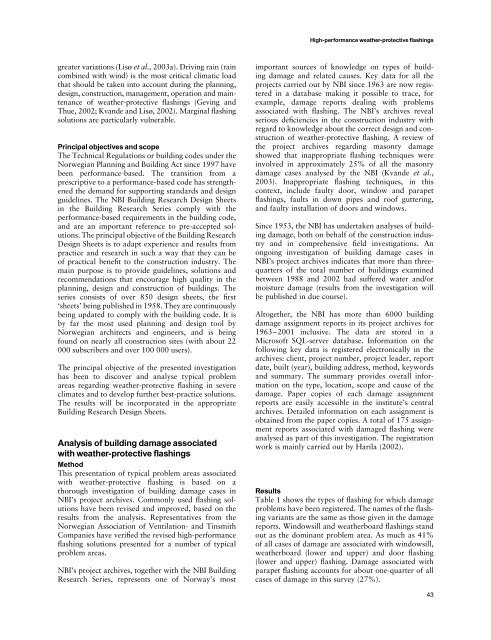Lisø PhD Dissertation Manuscript - NTNU
Lisø PhD Dissertation Manuscript - NTNU
Lisø PhD Dissertation Manuscript - NTNU
Create successful ePaper yourself
Turn your PDF publications into a flip-book with our unique Google optimized e-Paper software.
greater variations (<strong>Lisø</strong> et al., 2003a). Driving rain (rain<br />
combined with wind) is the most critical climatic load<br />
that should be taken into account during the planning,<br />
design, construction, management, operation and maintenance<br />
of weather-protective flashings (Geving and<br />
Thue, 2002; Kvande and <strong>Lisø</strong>, 2002). Marginal flashing<br />
solutions are particularly vulnerable.<br />
Principal objectives and scope<br />
The Technical Regulations or building codes under the<br />
Norwegian Planning and Building Act since 1997 have<br />
been performance-based. The transition from a<br />
prescriptive to a performance-based code has strengthened<br />
the demand for supporting standards and design<br />
guidelines. The NBI Building Research Design Sheets<br />
in the Building Research Series comply with the<br />
performance-based requirements in the building code,<br />
and are an important reference to pre-accepted solutions.<br />
The principal objective of the Building Research<br />
Design Sheets is to adapt experience and results from<br />
practice and research in such a way that they can be<br />
of practical benefit to the construction industry. The<br />
main purpose is to provide guidelines, solutions and<br />
recommendations that encourage high quality in the<br />
planning, design and construction of buildings. The<br />
series consists of over 850 design sheets, the first<br />
‘sheets’ being published in 1958. They are continuously<br />
being updated to comply with the building code. It is<br />
by far the most used planning and design tool by<br />
Norwegian architects and engineers, and is being<br />
found on nearly all construction sites (with about 22<br />
000 subscribers and over 100 000 users).<br />
The principal objective of the presented investigation<br />
has been to discover and analyse typical problem<br />
areas regarding weather-protective flashing in severe<br />
climates and to develop further best-practice solutions.<br />
The results will be incorporated in the appropriate<br />
Building Research Design Sheets.<br />
Analysis of building damage associated<br />
with weather-protective £ashings<br />
Method<br />
This presentation of typical problem areas associated<br />
with weather-protective flashing is based on a<br />
thorough investigation of building damage cases in<br />
NBI’s project archives. Commonly used flashing solutions<br />
have been revised and improved, based on the<br />
results from the analysis. Representatives from the<br />
Norwegian Association of Ventilation- and Tinsmith<br />
Companies have verified the revised high-performance<br />
flashing solutions presented for a number of typical<br />
problem areas.<br />
NBI’s project archives, together with the NBI Building<br />
Research Series, represents one of Norway’s most<br />
High-performance weather-protective £ashings<br />
important sources of knowledge on types of building<br />
damage and related causes. Key data for all the<br />
projects carried out by NBI since 1963 are now registered<br />
in a database making it possible to trace, for<br />
example, damage reports dealing with problems<br />
associated with flashing. The NBI’s archives reveal<br />
serious deficiencies in the construction industry with<br />
regard to knowledge about the correct design and construction<br />
of weather-protective flashing. A review of<br />
the project archives regarding masonry damage<br />
showed that inappropriate flashing techniques were<br />
involved in approximately 25% of all the masonry<br />
damage cases analysed by the NBI (Kvande et al.,<br />
2003). Inappropriate flashing techniques, in this<br />
context, include faulty door, window and parapet<br />
flashings, faults in down pipes and roof guttering,<br />
and faulty installation of doors and windows.<br />
Since 1953, the NBI has undertaken analyses of building<br />
damage, both on behalf of the construction industry<br />
and in comprehensive field investigations. An<br />
ongoing investigation of building damage cases in<br />
NBI’s project archives indicates that more than threequarters<br />
of the total number of buildings examined<br />
between 1988 and 2002 had suffered water and/or<br />
moisture damage (results from the investigation will<br />
be published in due course).<br />
Altogether, the NBI has more than 6000 building<br />
damage assignment reports in its project archives for<br />
1963–2001 inclusive. The data are stored in a<br />
Microsoft SQL-server database. Information on the<br />
following key data is registered electronically in the<br />
archives: client, project number, project leader, report<br />
date, built (year), building address, method, keywords<br />
and summary. The summary provides overall information<br />
on the type, location, scope and cause of the<br />
damage. Paper copies of each damage assignment<br />
reports are easily accessible in the institute’s central<br />
archives. Detailed information on each assignment is<br />
obtained from the paper copies. A total of 175 assignment<br />
reports associated with damaged flashing were<br />
analysed as part of this investigation. The registration<br />
work is mainly carried out by Harila (2002).<br />
Results<br />
Table 1 shows the types of flashing for which damage<br />
problems have been registered. The names of the flashing<br />
variants are the same as those given in the damage<br />
reports. Windowsill and weatherboard flashings stand<br />
out as the dominant problem area. As much as 41%<br />
of all cases of damage are associated with windowsill,<br />
weatherboard (lower and upper) and door flashing<br />
(lower and upper) flashing. Damage associated with<br />
parapet flashing accounts for about one-quarter of all<br />
cases of damage in this survey (27%).<br />
43














![Diagnosis and FTC by Prof. Blanke [pdf] - NTNU](https://img.yumpu.com/12483948/1/190x245/diagnosis-and-ftc-by-prof-blanke-pdf-ntnu.jpg?quality=85)

